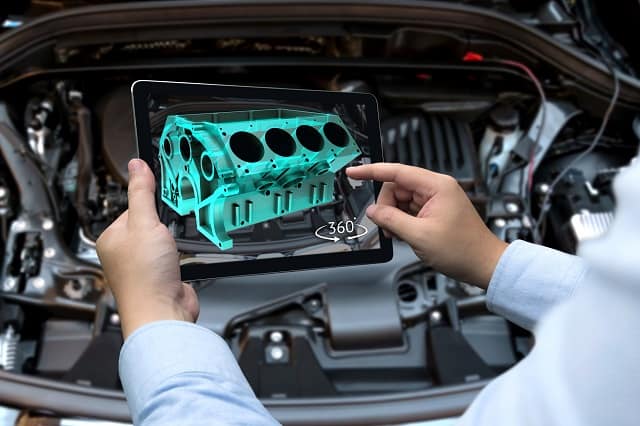What Is the Difference Between AR, VR, and Mixed Reality?
Advances in virtual and augmented reality technologies are increasingly blurring the lines between the virtual and real worlds. It is increasingly challenging to tell the various ‘reality’ technologies apart. So you might ask yourself, what makes Augmented Reality (AR), Virtual Reality (VR), and Mixed Reality(MR) different?
The difference between AR, VR, and MR is that AR overlays (adds to) and enhances a user’s experience of their actual reality. VR creates a 3D immersive experience where the user inhabits a virtual or simulated world. MR combines AR and VR and describes various applications between reality and virtuality.
If all these terms sound confusing, don’t feel alone. The rapid technological advances leave many of us behind as we hurtle towards an uncertain future. This article will explain the differences between these confusing terms and how they are used today.
OPTIVLY and (x)R
Optivly builds and develops interactive learning experiences in all formats (AR, VR, and MR). Check out our VRTY page to see an example of development in a Virtual Reality/Mixed Reality environment and our RealWear page to see an example of how we use Augmented Reality to enable engaging learning experiences. We have also developed an AR app for a client to help train butchers on correct knife sharpening techniques.
What Is AR (Augmented Reality)?
Augmented Reality provides an interactive experience based in a real-world environment rather than attempting to create a virtual simulation of another world. In other words, it ‘augments’ (adds to) reality. A good example of this is the Microsoft HoloLens which inserts objects into the real world courtesy of a kind of ‘heads up display.
Computer-generated information is relayed to the users’ senses to enhance the objects within the real world through multiple sensory interactions between user and computer. Using the HoloLens example again, you can bring up a virtual touchpad in ‘mid air’ and then, via hand tracking, you can ‘click’ or select the touchpad to achieve the desired function, e.g., make a Teams call.
Augmented reality can either enhance the sensory experiences of the real environment or function to mask the natural environment by overlaying sensory information.
The augmented reality experience seamlessly interweaves with the user’s perception of the real world, making the experience feel like it is part of the real world.
The immersive aspects of AR may include:
| Visual | Olfactory |
| Tactile | Auditory |
| Perception by active touch (haptic.) |
What is AR Used For?
AR has a wide range of practical applications. In the healthcare industry, for example, a Doctor can look at a patient and then bring up useful data to help with diagnosis or understand patient history while performing an investigation. In the manufacturing industry, an engineer can bring up schematics of an engine that they may be servicing in real-time.
Augmented reality aims to blend components of the digital world and the user’s perceptions of the real world. AR functions in an immersive manner through their senses rather than an overlaid display of data so that the user perceives the experience as part of their natural environment.
First explored by the US Air Force in the 1900s; augmented reality is gaining increased adoption and usage in industries as diverse as:
| Entertainment | Oil and Gas |
| Education | Medicine |
| Communications | Manufacturing |
What Is VR (Virtual Reality)?
Virtual reality is a digital-based immersive experience that allows users to perceive a simulated reality that they may explore in 360°. Unlike AR, VR can place the user in a virtual environment that may be completely different from their existing reality.
The most common form factor for VR is via consumer VR headsets or multi-projected environments where users can move around the virtual world and interact with virtual features.
VR also incorporates auditory feedback but may also embrace other sensory experiences through haptic technology.
With the much talked about, but perhaps not understood, Metaverse on the rise, future VR will become more of a cloud service, and AI-backed VR will offer us increasingly complex and personalized virtual worlds to explore.
What Is VR Used For?
Although many of us associate it with entertainment and gaming, VR’s applications are endless. One of the early value propositions for VR is the ability to put people safely into unsafe situations. A mining company is able to simulate a dangerous roof collapse in VR without putting anyone in danger. A science organisation can simulate an issue with a lab explosion and allow people to experience what they need to do in an emergency. The ability to consistently repeat a scenario and train people on how to react with very low operating costs and long shelf life makes investment in VR a compelling argument.
The value of VR is that the human brain finds it almost impossible to distinguish fact from fiction in terms of the lymbic and emotional response. Your pre-frontal cortex tells you that the 6-foot 6″ boxer lining up to knock you out is not actually Ivan Drago, but when he starts swinging, you make like Rocky Balboa, and you do your darndest to get out of the way. Your adrenaline and cortisol reactions are identical to being in an actual fight.
Through these virtual experiences, we can learn, experiment, and be entertained.

What is MR (Mixed Reality)?
Mixed reality combines augmented and virtual reality and merges the real and virtual worlds to create new environments and experiences. In MR, the physical and digital exist in the same space and simultaneously incorporate digital overlays and immersive simulation.
MR is part of the Mediated Reality Continuum, where reality and virtuality are not separate entities but part of a continuum. Mixed reality is a term that can describe applications that reside between reality and virtuality.
Mixed reality unlocks natural and intuitive 3D human/computer/environment interactions and incorporates technologies such as display systems, graphical processing, input systems, and cloud computing.
What Is MR Used For?
Although MR is only in its infancy, the possibilities of MR experiences are limitless. Mixed reality allows people to interact with virtual elements and digital objects to interact with the physical environment as though they are real.
For example, RealWear is a practical and useful example of MR. Mining companies can conduct equipment audits using RealWear headsets onsite rather than flying out teams of people. Real-time video and photos can be captured and entered into the audit system using voice commands. Trainers can assess a student’s competency via a surrogate wearing the headset rather than having to be physically onsite.
AR, VR, Mixed Reality Q; A
| Augmented Reality allows users to interact meaningfully with their real-world virtually, enhancing their experience, engagement, and interaction. |
| Virtual reality creates a simulated reality where users can explore places and experiment with an artificial environment for entertainment, education, and training. |
| Mixed Reality benefits allow users to secure digital objects in the real world and create a new space where both the virtual and digital worlds exist simultaneously. |
Can AR and VR Work Together?
AR and VR can and do work exceptionally well together under the banner of mixed reality. Mixed reality combines the enhancements of reality provided by AR and the virtual environment to allow users to interface between the real and virtual sphere in a meaningful and productive manner.
Is Mixed Reality the Future of AR and VR?
With a global market projected at USD 5811.09 million by 2026, mixed reality is the wave of the future. Both AR and VR technologies are incorporated in the Median Reality Continuum, where reality and virtuality are part of the same spectrum.
Conclusion
Reality and simulation are becoming increasingly blurred as technology races forward. However, the VR and AR, and Mixed Reality spheres show great promise for benefits in almost every field of modern life. We are lucky enough to be in the virtual front seats for the show.
